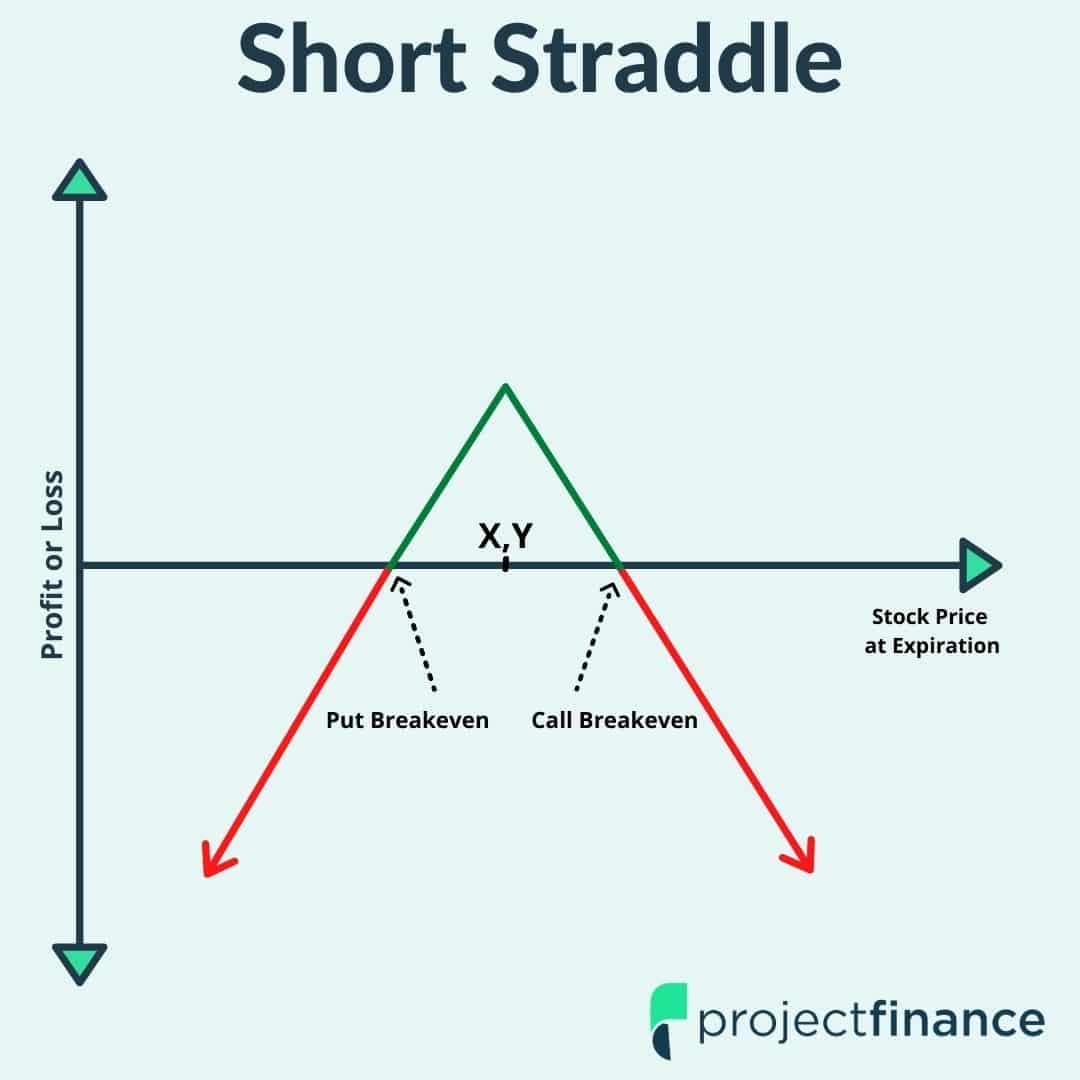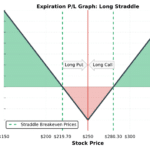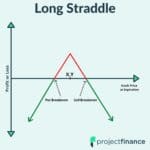Last updated on April 5th, 2022 , 06:26 am
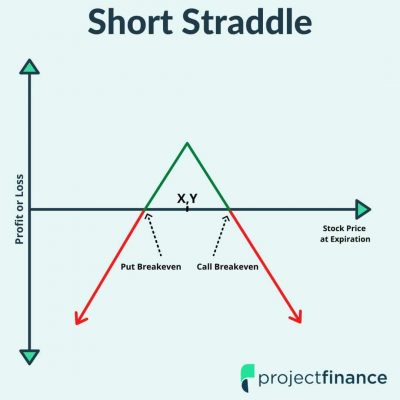
The short straddle is an options strategy that consists of selling call and put option on a stock with the same strike price and expiration date.
Most of the time, a short straddle trader will sell the at-the-money options. Since the sale of an at-the-money call is a bearish strategy, and selling a put is a bullish strategy, combining the two into a short straddle results in a directionally neutral position. However, as the stock price changes, the trade will become directional and can suffer significant losses.
When selling straddles, profits come from the passage of time or decreases in implied volatility, as long as the stock price remains within the breakeven points of the position. Selling straddles is very similar to selling strangles, with the only difference being that the short call and put share the same strike price.
TAKEAWAYS
- The short straddle is best suited for neutral, or “sideways” market direction.
- One short call and one short put comprise this strategy.
- The loss on this strategy is infinite because of the short call sold.
- Total profit is limited to the credit received.
Short Straddle Strategy Characteristics
Max Profit Potential: Total Credit Received x 100
Max Loss Potential: Unlimited
Expiration Breakevens:
➥Upper Breakeven = Strike Price + Total Credit Received
➥Lower Breakeven = Strike Price – Total Credit Received
Estimated Probability of Profit: Generally between 50-60%.
To demonstrate these characteristics in action, let’s take a look at a basic example and visualize the position’s potential profits and losses at expiration.
Short Straddle Profit/Loss Potential at Expiration
In the following example, we’ll construct a short straddle from the following option chain:
In this case, we’ll sell the 250 call and 250 put. Let’s also assume the stock price is $250 when entering the trade.
Initial Stock Price: $250
Short Strikes Used: 250 put, 250 call
250 Put Sale Price: $15.10
250 Call Sale Price: $15.20
Total Credit Received: $15.10 + $15.20 = $30.30
The following visual describes the potential profits and losses at expiration when selling this particular straddle:
Short Straddle Chart
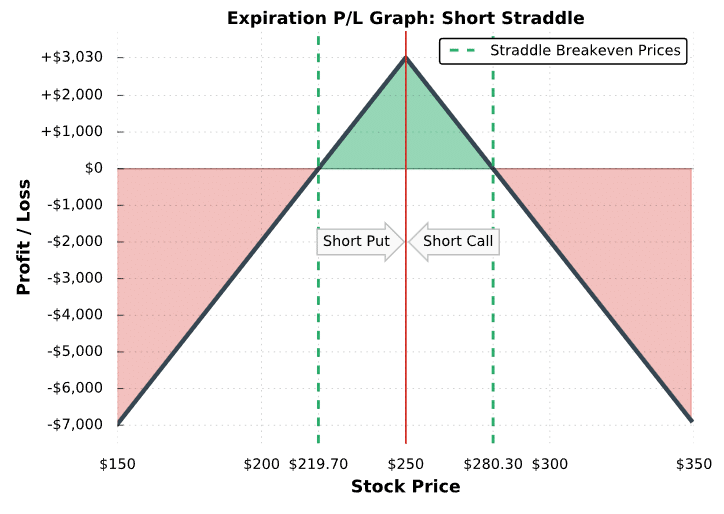
As illustrated here, a short straddle realizes maximum profit when the stock price is trading exactly at the short strike at expiration. Because of this, achieving maximum profit on a short straddle is very unlikely.
However, since a short straddle collects the most extrinsic value compared to any other option selling strategy, taking partial profits on a short straddle can lead to more profits than making maximum profit on other less aggressive strategies.
The sections below explain the why behind the profit/loss levels at various stock prices at the time of expiration:
➥Stock Price Below the Lower Breakeven Price ($219.70):
The 250 call expires worthless but the short 250 put has more intrinsic value than the entire straddle was sold for ($30.30), and therefore the straddle seller realizes a loss.
➥Stock Price Between the Lower Breakeven and the Short 250 Put ($219.70 to $250):
The 250 put has intrinsic value, but not more than the premium the trader collected when selling the straddle. The 250 call expires worthless. Consequently, the short straddle position is profitable.
➥Stock Price Between the Short Call Strike and the Upper Breakeven ($250 to $280.30):
The 250 call has intrinsic value, but not more than the premium the trader collected when selling the straddle. The 250 put expires worthless. Consequently, the short straddle position is profitable.
➥Stock Price Above the Upper Breakeven ($280):
The 250 put expires worthless but the 250 call has more intrinsic value than the straddle was sold for, and therefore the short straddle position is not profitable. Since the stock price can rise indefinitely, the short call (and consequently the entire short straddle) has unlimited loss potential.
Great job! You’ve learned the general characteristics of the short straddle strategy. Now, let’s go through some visual trade examples to show you how selling straddles really works.
Short Straddle Trade Examples
To visualize the performance of straddles relative to the stock price, let’s look at a few examples of real straddles that recently traded. Note that we don’t specify the underlying, since the same concepts apply to short straddles on any stock. Additionally, each example demonstrates the performance of a single straddle position. When trading more contracts, the profits and losses in each case will be magnified by the number of straddles traded.
Let’s do it!
Trade Example #1: Highly Profitable Short Straddle Trade
The first example we’ll look at is a situation where the stock price trades in a tight range after an at-the-money straddle is sold, resulting in plenty of profits.
Here are the trade entry details:
Initial Stock Price: $210.72
Initial Implied Volatility: 15%
Strikes and Expiration: 211 put and 211 call expiring in 77 days
Straddle Sale Price: $5.46 for the put and $4.32 for the call = $9.78 total credit
Breakeven Prices: $201.22 and $220.78 ($211 – $9.78 and $211 + $9.78)
Maximum Profit Potential: $9.78 net credit x 100 = $978
Maximum Loss Potential: Unlimited
Let’s visualize what happens that allows this trade to profit!
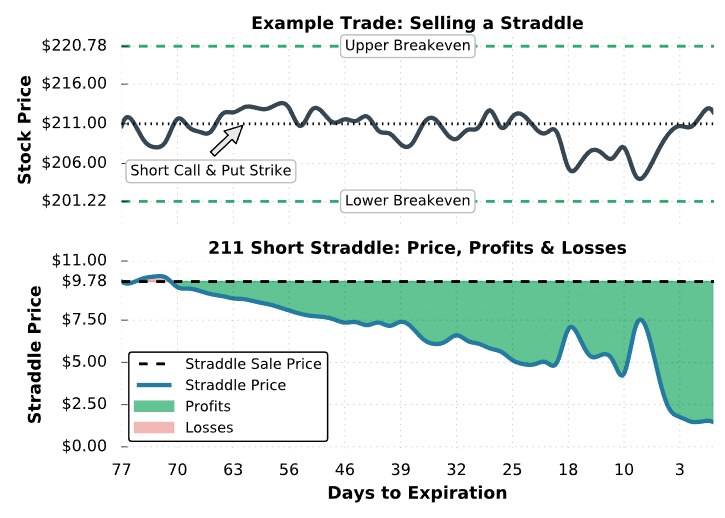
Short Straddle #1 Trade Results
As you can see, selling straddles can be highly profitable when the stock price doesn’t rise or fall quickly with magnitude. In this case, the stock price traded near the short strike the entire time, leading to profits from time decay. Implied volatility remained near 15% the entire period, so a change in implied volatility really wasn’t a factor here.
In this example, the straddle price continously fell, presenting many opportunities for the short straddle trader to close the position early for profits. To lock in the profits or losses on a short straddle position, the short options can be simultaneously bought back at their current prices. For example, if the trader in this position bought back the straddle for $5.00, they would have locked in $478 in profits: ($9.78 initial sale price – $5.00 closing price) x 100 = +$478.
At expiration, the stock price was above $211, which means the short call was in-the-money and the short put was out-of-the-money. However, the short 211 call only had $1.50 of intrinsic value at expiration, which results in a $828 profit for the straddle seller: ($9.78 sale price – $1.50 expiration value) x 100 = +$828.
Trade Example #2: Large Loss
In the next example, we’ll look at how a short straddle performs when the stock price falls significantly. In particular, we’ll examine a short straddle on a stock in late 2008.
Here are the trade details:
Initial Stock Price: $126.20
Initial Implied Volatility: 23%
Strikes and Expiration: 126 put and 126 call expiring in 78 days
Straddle Sale Price: $5.18 for the put and $5.07 for the call = $10.25 total credit
Breakeven Prices: $115.75 and $136.25 ($126 – $10.25 and $126 + $10.25)
Maximum Profit Potential: $10.25 net credit x 100 = $1,025
Maximum Loss Potential: Unlimited
Let’s visualize what goes wrong, causing the trade to lose money:
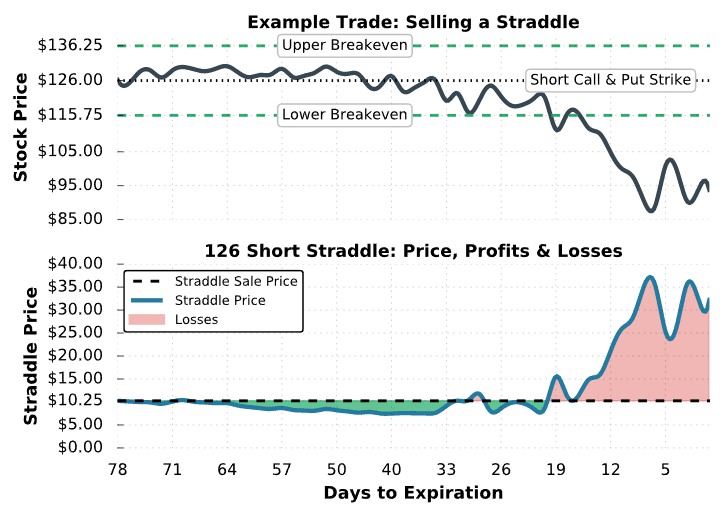
Short Straddle #2 Trade Results
As you can see here, the short straddle position did ok in the first 40 days of the period. However, the stock price suddenly collapsed from $125 to $95. At the same time, implied volatility in the expiration cycle of the short straddle spiked to over 75%. Consequently, the price of the 126 straddle surged in price to $35. With an initial sale price near $10, the loss is $2,500 per short straddle when the straddle is worth $35.
If the trader wanted to take losses before expiration, the straddle can be bought back at its current price. For example, if the straddle was bought back for $25, the trader would have locked in $1,475 in losses: ($10.25 initial sale price – $25 closing price) x 100 = -$1,475.
At expiration, the stock price was $31 below the straddle’s strike price of $126, which translates to $31 of intrinsic value for the 126 put and $0 of intrinsic value for the 126 call. Because of this, the expiration loss for the straddle seller is $2,075: ($10.25 initial sale price – $31 final straddle value) x 100 = -$2,075.
Changes in a Short Straddle's Delta/Directional Exposure
In addition to demonstrating the potential losses from selling straddles, this example serves as an excellent demonstration of how a straddle’s position delta can change rather quickly.
As mentioned earlier, a short straddle position has negative gamma, which means that as the stock price trends in one direction, the delta (directional risk) of the position will grow in the opposite direction.
For example, if the stock price increases, the delta of a short straddle position will become more negative, resulting in a bearish position. Conversely, when the stock price decreases, the delta of a short straddle position will grow more positive, resulting in a bullish position.
Let’s visualize the concept of negative gamma using the same example as above:
Straddle vs Delta
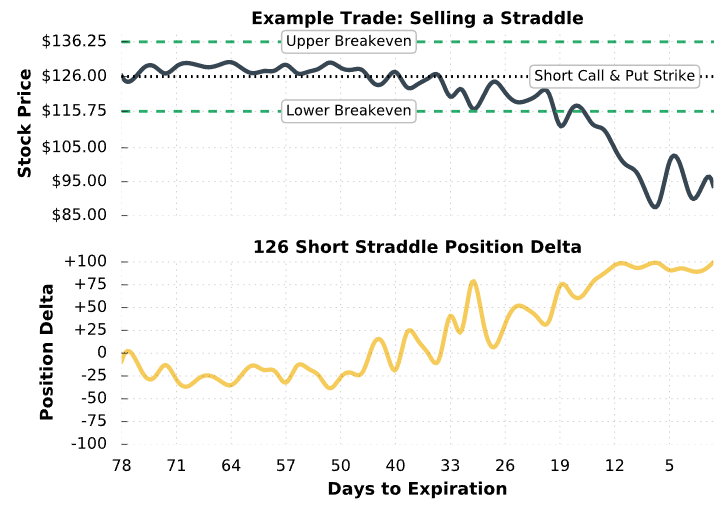
As visualized here, the position delta of the short straddle moves inversely with the stock price. When the stock price increases, the position delta becomes more negative, which means the position is more bearish. When the stock price decreases, the position delta becomes more positive, which means the position is more bullish. Intuitively, this should make sense because the maximum profit potential of a short straddle occurs when the stock price is right at the strike price.
Therefore:
When the stock price falls below the strike price, the position becomes bullish because the ideal scenario is for the stock price to rise back up to the strike price.
When the stock price rises above the strike price, the position becomes bearish because the best case scenario is for the stock price to fall back down to the strike price.
Trade Example #3: Breakeven Short Straddle
In the final example, we’ll look at a scenario where a short straddle trader doesn’t make or lose much money, which occurs when the stock price is near one of the straddle’s breakeven prices at expiration.
Here are the trade details:
Initial Stock Price: $210.56
Strikes and Expiration: 211 put and 211 call expiring in 60 days
Straddle Sale Price: $4.83 for the put and $3.51 for the call = $8.34 total credit
Breakeven Prices: $202.66 and $219.34 ($211 – $8.34 and $211 + $8.34)
Maximum Profit Potential: $8.34 net credit x 100 = $834
Maximum Loss Potential: Unlimited
Let’s see what happens that causes the trade to break even:
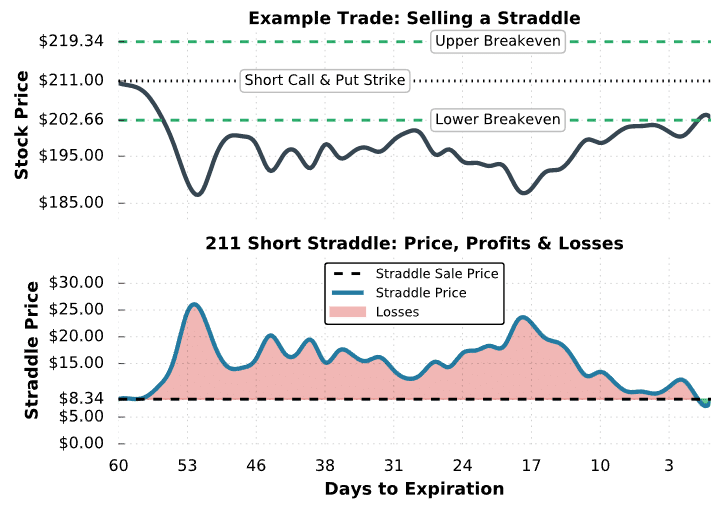
Short Straddle #3 Trade Results
As we can see here, the stock price fell significantly after the short straddle was entered. As a result, the position had losses over the entire period. At the worst point, the loss on the short straddle was nearly $1,700.
Fortunately, the stock price rallied back to the short straddle’s lower breakeven price. At expiration, the 211 put had slightly less than $8.34 of intrinsic value, which means the position squeaked out a tiny profit because the initial straddle sale price was $8.34.
Regarding a share assignment, the short 211 put is in-the-money at expiration, which means the trader would be assigned +100 shares of stock if the put was held through expiration (if not already assigned shares early).
Final Word
Let’s briefly review a few of the key concepts we have learned:
- When the stock prices breaks one of the strike prices sold, the straddle can experience significant losses.
- In the straddle, the most you can ever make is the credit received.
- Short straddles have a negative gamma, which has an inverse relationship with delta.
Curious how the strangle compares to the straddle? Check out our article here, Straddles vs Strangles.

